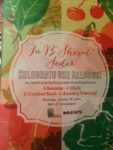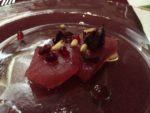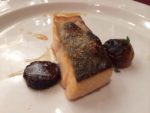When I was growing up, Tu B’Shevat was one of those second (or third) tier holidays that didn’t require my presence at services. Frankly, all those years of Hebrew school and I remember nothing except the trees of course. I’ll go out on a limb (yeah yeah) and say that I’m not alone.
So when I saw what Beth El was doing this year to celebrate Tu B’Shevat, I jumped at the chance to participate. A Tu B’Shevat Seder to celebrate the seasons with eight courses of food and wine — all created by 4 amazing local chefs??? Yes, please.
Before I get down to the nitty gritty, I just want to commend Rabbi Avi Olitzky for hosting such an event (and I’m not just saying that because he’s on the TC Jewfolk board). Events like these have an energy and a relevance that make people like me want more. Of course 8 glasses of wine didn’t hurt, but the mood of the packed house was off the charts. It proved to me that Jewish learning can take many forms — and if done well, can be appealing to almost everyone (Jewish or not).
Each chef was assigned a season to create two dishes. Each dish utilized at least one of the seven species: wheat, barley, grape (wine), fig, date (honey), pomegranate, and olive (oil). And all eight courses were paired with selected wines including three from Israel. The chefs introduced their dishes and explained their seasonal inspirations.
The first two courses by Chef Mike DeCamp from La Belle Vie were incredibly light and clean – just like Spring should be. Lamb tartare followed by a salad of melon, hearts of palm, honey, and radish had me thinking of melting snow and one of those kosher hot dogs at Target Field.
The two courses by Chef Jamie Malone (one of Food & Wine‘s Best New Chefs in America) from Sea Change were better suited for a summer’s eve on the patio than a synagogue ballroom with sub-zero wind chills outside — but they were still quite delicious. A super fresh and summery raw ahi tuna led to the first warm dish of the night — grilled arctic char with fig, onion, and honey. While I was thrilled to see the underrated arctic char and its crispy skin, some of my table mates thought it was an odd-tasting salmon.
We entered fall with two dishes by Chef Phillip Dorwart of Create Catering. They went from rich to richer — exactly what we need when the mercury drops from September-December. A spiced chicken with a delicious pomegranate molasses led right into one of the highlights of the night — a beef short rib ravioli. Finished with olive oil, olives, toasted pine nuts, and a crisp shallot gremolata I could have had at least six. And the rest of my table felt the same way.
There was a nice little break between fall and winter — probably done intentionally so we could drink more wine and forget about the bone-chilling winds outside during actual winter. But when Chef Dawn Douillard of Fabulous Catering presented her grilled lamb chops, there was a collective gasp of joy. The heartiest dish of the night was perfect and a great way to end the savory portion of the meal. The eighth and final course was a pomegranate and zinfandel poached pear with chocolate, hazelnuts, and honey. Rich enough for winter and light enough to transition back to spring.
After 8 courses and over 3 hours, we were on our way — braving the low temps and praying for spring to arrive. But as I count down the days, I’ll have a new appreciation for the seasons, for the trees that change with the seasons, and for Tu B’Shevat. What do the Jews in Hawaii do — home of just one season? Must be interpretive.
- Lamb tartare from Chef Mike DeCamp of La Belle Vie
- Spring salad from Chef Mike DeCamp of La Belle Vie
- Raw Ahi Tuna from Chef Jamie Malone of Sea Change
- Arctic Char from Chef Jamie Malone of Sea Change
- Spiced chicken from Chef Phillip Dorwart of Create Catering
- Beef short rib ravioli from Chef Phillip Dorwart of Create Catering
- Grilled lamp chop from Chef Dawn Douillard of Fabulous Catering
- Pomegranate and zinfandel poached pear from Chef Dawn Douillard of Fabulous Catering










